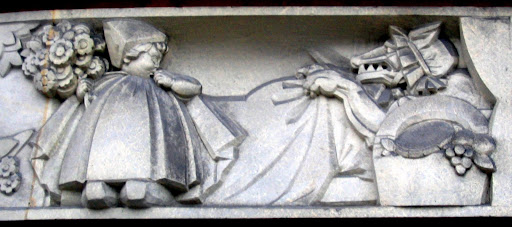Sadler and Clegg senior loved art and were to realise the benefits it may bring to education in distinct ways. Clegg junior, a pupil at the school, later recalled:
The County Secondary School at Long Eaton in Derbyshire where my father was the first headmaster set my standards. Its corridors and classrooms were panelled, and above the panelling in... [one] classroom were beautifully painted friezes of the Chaucer Tales. There was also a Milton room, a French room, a room with paintings of local lace factories. Copies of famous works of art in facsimile frames made in the school woodwork room were hung in the corridors and classrooms and showcases in the hall were used for the display of Greek coins and Japanese netsuke, and other small articles of beauty... I never recall any abuse of the school walls by the pupils.
(Alec Clegg, About our Schools, 1980, 120-121)
Sadler's 1905 report recommending the creation of the school noted that drawing should be emphasised in the education provided, not least 'for the benefit of future lace designers... since the staple trade of the area was lace.' This coincided with Clegg's belief, elaborated in his 1918 book 'Drawing and Design', 'in art as the means of providing a first class education for the child, a means which blends enjoyment and profit as no other can do.' (R. Hough, Long Eaton Grammar School Jubilee Book, 1960).
The online Belgian Artists Dictionary Illustrated (Nobel) has an entry for Rosa Pauwaert (née Vaerwijck), 1887-1966, an artist from Ghent, which reads: 'Durant la Première Guerre Mondialle, elle séjourne à Londres et y enseigne à l'Ecole des Beaux Arts de Long Eaton. Y réalise également des peintures murales.' The online resources that I've looked at for the renowned Roger Bissière (1886-1964), don't mention what is surely his work at Long Eaton, but do note that having completed his art studies in 1911 he travelled to England.
Without so far having visited the school or trawled any archives I can only report secondhand, using the 1960 fiftieth jubilee book, on the Long Eaton 'Ecole des Beaux Arts/County Secondary School':
'1914 brought refugees from Beligum... Mlle Vaerwyck, later Mme Pauwaert, joined the staff...[She] was a fine artist and with Miss Nowell she painted the murals which remained showpieces of the school until 1948. Room 5 was so decorated as to be known as the Milton Room; Room 4 was the Tudor Room; Room 3 was decorated with French landscape and was the French Room; while local trade was honoured in Room 7, which became the Lace Room. This mural decoration of classrooms was an expression of Mr. Clegg's ideas about presenting art to children incidentally, as part of their environment. In 1911 when a French artist, M. Bissiere had been on the staff for a short time as Art Master, Mr. Clegg had seized the opportunity to persuade him to paint a mural of the Canterbury Pilgrims in Room 6. It was from this painting that the room became known as the Chaucer Room; and the murals of Mlle. Vaerwyck were an extension of this mural decoration... ' (R. Hough, 25)
and
'... if the first impact of war robbed us of our masters, its second effect was no doubt the arrival of Belgian refugees. And with them came that remarkable lady, Mlle. Rosa Vaerwyck, later known as Mme. Pauwaert. Under her guidance the art room became a favourite place in the school, and as she moved so quietly and gently from one pupil to another she not only told us what to do, but showed us how it should be done. One of the first things we did together was a large poster of Santa Claus in all his scarlet splendour, appealing for help for the refugees: one of our first works to be 'hung' - this time in Long Eaton market place! Her later contributions included the beautiful murals in the Milton Room and Tudor Room, now alas! obliterated.' (J. Dawson Hooley [Canon Hooley of Sheffield Cathedral], 1914-1919)
Perhaps someone knows of colour images of the decorated rooms at Long Eaton? It would be superb to see them. As yet I have just been able to find the black and white images herewith of the Chaucer and French Rooms. Nothing of the others. Yet even these morsels are full of intrigue and signs... of educational ideas, of style, perhaps of a coming together of French & Belgian Art Nouveau with English Arts & Crafts, of a predecessor to James Selbie's ceramic mural of the Canterbury Tales at the Waid Academy which I've written/posted/talked about before... I want to go further with them... To see more clearly, for instance, how literature, history, culture, trade and art are being presented... And I'd like to convincingly place (or indeed have someone place) the murals within the artistic development of Bissière and Vaerwyck...
Apparently the part of the school which the murals are/were in has been sold off relatively recently. Who knows, perhaps the murals could be recovered. If the owners knew that they have one of the earliest Bissière's under their noses and layers of paint, they may well be induced to restore it... I'd like to see them all - to get an idea of Clegg's concept, a concept that was so critical for his son Alec when he later (1945-74) was to be Chief Education Officer of the West Riding of Yorkshire.... A concept realised at the birth of the new decorated school movement in Britain.
I am grateful to John Simpson for the photographs of the murals from the Long Eaton Grammar School-Reunited website: www.legsreunited.org.uk




